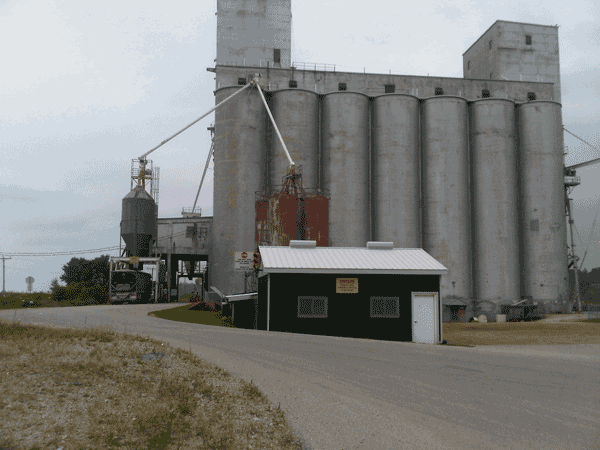Grain terminals: international gateways for Ontario grains
.
it’s not often grain terminals make the news, but in 2011 Parrish and Heimbecker’s Hamilton Harbour terminal built a new grain handling facility and South Pier Terminal in Goderich was struck by a tornado. Both were newsworthy stories for their own reasons that caught the attention of Ontario farmers and the general public. Grain terminals are longstanding icons in the Ontario agricultural landscape and serve as the gateway to the world for our grain. Without them, Ontario’s grain wouldn’t be exported as efficiently or successfully as it is today.
supporting farmers and feeding the world
Ontario grain terminals play an important role in moving grain to export markets, providing storage capacity and reducing domestic surplus.

Without an export market or shipping facilities Ontario’s grain prices would plummet, simply because our domestic consumption is nowhere near our production. Rising yields means there is more grain in the market today than in the past and with less feed demand for domestic grains, we have more grain than ever before. “There is more exportable grain in Eastern Canada today than we had 50 years ago,” says Steve Kell, business development manager with Parrish and Heimbecker (P&H), Eastern Canada. It’s no surprise that domestic consumption can’t keep up with the increased efficiencies farmers are realizing. Kell says, “farming is the best industry to adopt efficiencies. However, the additional supply is only good if there is a market. And combining export markets with increased product means greater profitability for Ontario farmers.”
Roughly 50 percent of all Ontario corn, soybeans and wheat are exported annually, explains Terry Barros, grain terminal manager at the Cargill Sarnia terminal. Barros also believes terminals play a complimentary role in taking the oversupply of grains while returning monetary benefits to farmers. And the high volume of exports means grain terminals are more important to a farmer’s bottom line than ever before.
Kell sees grain terminals as an important gateway where ships are loaded and sent off to various parts of the world. Most grains leaving Eastern Canadian ports, including Ontario are exported to Europe, Africa, the Middle East, the Mediterranean and Asia.
increasing storage capacity
Terminals also act as shock absorbers in the supply chain, especially during harvest. “Terminal storage facilities offer warehousing facilities and create a cushion when everyone is moving grain at the same time,” says Kell. That’s why P&H recently invested in a new high tech grain handling facility at their Hamilton Harbour location.
Harvest time in Ontario doesn’t just mean storage space is limited, the flood of grain to the market place also means prices are historically at their lowest point. Barros explains one of the biggest challenges to terminals is the ability to move enough grain as efficiently as possible during harvest. Market prices also dictate when terminals will be busy since commodity grains are price-takers, Barros says “if the price is right everyone wants to sell at the same time.” Moving grain as fast as possible, especially during harvest or trying to beat the winter weather when the great lakes freeze over for three months, is a constant challenge for grain terminals. That’s why Barros agrees with Kell and the expansions P&H is making, he says Cargill is always looking for upgrades to become more efficient and predicts most other terminals are likely doing the same.
Farmers know on-farm storage can help reduce the seasonal influx of grain. In fact, Barros says on-farm storage has increased every year in the past 10 years, with the increases primarily built for corn storage. Deferring delivery, or splitting up grain delivery over harvest, post-harvest or utilizing on-farm storage can help also spread out the volume of grain being moved in a short period of time.
In an industry where time is money, the same can be said for storage space and freight costs. Both farmers and terminals face freight costs, something Barros says can eat away at the end price and cut into the farmer’s profit. The further a farm is located from a terminal the higher the freight costs and, as in the recent case of the Goderich terminal where business was interrupted due to a tornado, if a load is redirected the costs can add up. Similarly, some of the biggest challenges facing terminals are vessel rate costs explains Kell, who is also frustrated by rail car supply.
Agriculture is the number one business with distinct market demand worldwide according to Kell and grain terminals are positioned to support the business with export opportunities, storage and grain handling facilities and marketing Ontario’s grain to international buyers. With rising yields, greater on-farm efficiencies and market savvy producers, Ontario’s farmers are ready to meet the worldwide demand head on.
P&H TERMINAL EXPANSION
The grain conveyance system and two dome storage areas built at the P&H Hamilton Harbour terminal are aimed to increase efficiencies. The new system can move 800 tonnes of product per hour loading or unloading ships.

Each concrete dome is nine stories high and about the width of a football field in diameter, each dome has the storage capacity for 28,000 tonnes and is expected to handle more than one million tonnes over the next 10 years. The expansion, completed in summer 2011, was designed to handle a variety of products, not just limited to grain. This first phase of expansion is designed to allow for further expansion and future project discussions are underway to increase storage facilities and improve rail capacity. •








